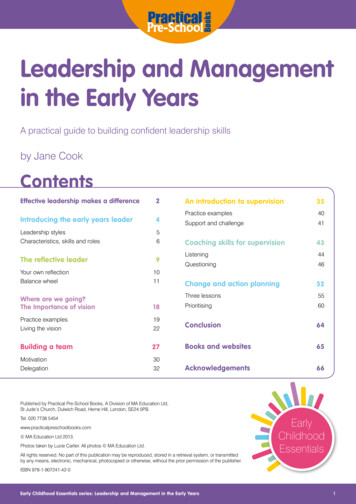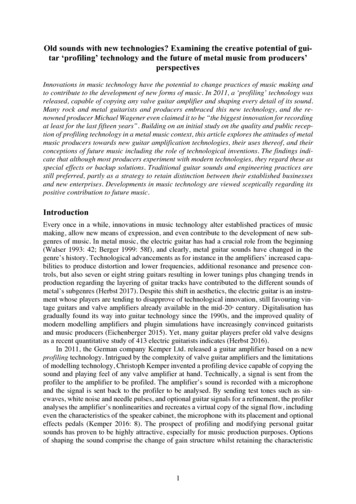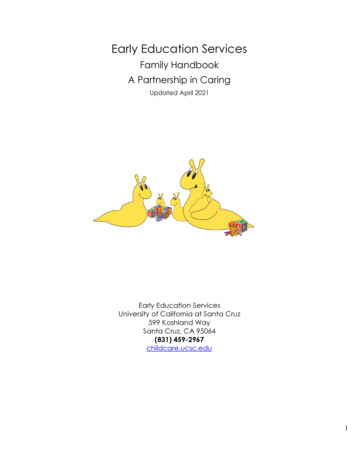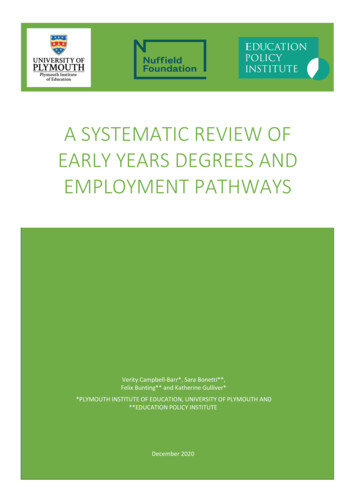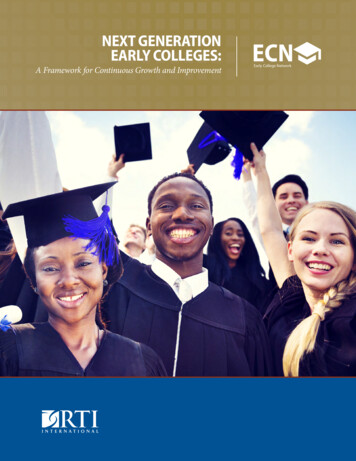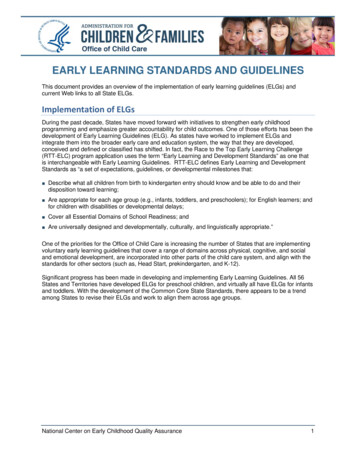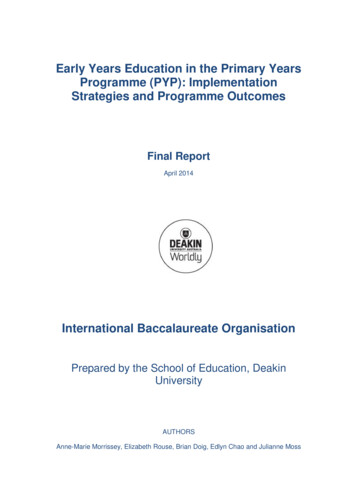
Transcription
Early Years Education in the Primary YearsProgramme (PYP): ImplementationStrategies and Programme OutcomesFinal ReportApril 2014International Baccalaureate OrganisationPrepared by the School of Education, DeakinUniversityAUTHORSAnne-Marie Morrissey, Elizabeth Rouse, Brian Doig, Edlyn Chao and Julianne Moss
ContentsExecutive Summary . 51.Introduction and Background. 92.Research Design . 102.1Recruitment. 122.2Data Collection . 123.Participating Sites . 153.1Introduction to the Sites. 163.1.1 Singapore Site 1 (S1) . 163.1.2 Singapore Site 2 (S2) . 183.1.3 Australian Site 1 (A1) . 213.1.4 Australian Site 2 (A2) . 234.Researcher Observations: Analyses and Comparisons of Programmes 254.1Programme Approaches, Philosphy and Goals . 264.1.1 IB PYP Early Years Programme . 264.1.2 Inquiry-based and conceptually driven curriculum . 284.1.3 Inquiry-based learning and the importance of relationships . 334.1.4 The PYP and Reggio Emilia . 354.2Learning Environments . 404.2.1 The place of the visual arts. 404.2.2 Child choice and ownership . 424.2.3 Outdoors and the natural world . 434.3Play and play-based curriculum . 494.4Discussion. 595.Measures of Literacy . 625.1Early Literacy in English Tools . 635.1.1 Concepts of Print . 675.1.2 Reading . 675.1.3 Early Writing . 675.1.4 Tool Administration. 675.1.5 Overall Literacy Levels . 695.2Singaporean Sites – S1. 705.3Singaporean Sites – S2. 715.4Australian Sites – A1 . 735.5Australian Sites – A2 . 745.6Summary. 766.Developmental School Readiness . 776.1The Who am I developmental assessment tool . 786.2The Sample. 786.3Scoring Who am I?. 806.4Analyses . 806.4.1 Sub-scale results . 836.4.2 Comparisons between Programmes. 886.5Summary. 897.Teacher Assessment of Children’s Learning Skills . 907.1The Learning Skills Measure . 907.2Analyses . 917.2.1 Sub-group analyses . 947.2.2 Comparisons . 95IB Early Years Project Final Report (April, 2014). Morrissey, Rouse, Doig, Chao & Moss (DeakinUniversity)2
7.2.3 Comparisons on a larger scale . 987.4Summary. 1008.Educator Perspectives . 1018.1Interview procedures . 1018.2Inquiry-based learning . 1028.3The Learner Profile Attributes. 1038.4Reggio Emilia and the PYP . 1058.5Working with Local Frameworks. 1068.6Play-based learning . 1078.7Academic learning and school readiness . 1088.8Learning Environments and Child ‘Ownership’ . 1108.9Relationships with Families . 1118.10 Summary . 1129.9.19.29.39.49.59.69.79.8PYP Coordinator Perspectives . 113Interview procedures . 113Inquiry based learning . 114Learner Profile . 115Connections with the Reggio Emilia Approach . 115Engaging families . 117Literacy and numeracy development . 118Issues and challenges . 119Summary. 12010 Children’s Perspectives . 12110.1 Child perspectives at S1. 12210.2 Child perspectives at S2. 12410.3 Summary. 12511. Family Perspectives . 12611.1 Interview procedures . 12611.2 Socio-Emotional & Life Skills Development . 12711.3 Individualised Learning. 12911.4 Family Engagement . 13111.5 School Readiness & External Expectations . 13311.6 What is an ‘IB School’? . 13411.7 Summary. 13512. The Early Years Programmes and National Frameworks . 13612.1 The Australian sites and the VELDF . 13712.2 The Singapore sites and the NEL . 13813. Conclusions and Recommendations . 140Recommendations . 14514.References . 146IB Early Years Project Final Report (April, 2014). Morrissey, Rouse, Doig, Chao & Moss (DeakinUniversity)3
TablesTable 1. Diverse perspectives on the programmes as data sourcesTable 2. AusVELS LevelsTable 3. Early Literacy in English Tools (ELET)Table 4. ELET Administration (by site, literacy tool and level)Table 5. Overall literacy levels (by research site and tool)Table 6. Sample sizesTable 7. Sample size by sexTable 8. Ages by ProgrammeTable 9. Mean percentage of highest scores by Australian norm group (Adaptedfrom de Lemos & Doig, 1999)Table 10. Percentage of top scores by ProgrammeTable 11. Number of top scores by countryTable 12. Item statements for LearningTable 13. Means and Standard Deviations for all groupsTable 14. Performance of Boys and GirlsTable 15. Effect Sizes for paired groups116365686979798086878891949697FiguresFigure 1. Scaled total scores on Who am I?Figure 2. Total raw scores on Who am I?Figure 3. Sub-scale scores on Copying itemsFigure 4. Sub-scale scores on Symbols itemsFigure 5. Sub-scale scores on Picture of Me itemFigure 6. Wright Map of IB students on SEW Learning strandFigure 7. IB students’ logit scores by ProgrammeFigure 8. Australian pre-schools performance against all schoolsFigure 9. Singapore Programmes’ performance against all schools818284858593959999IB Early Years Project Final Report (April, 2014). Morrissey, Rouse, Doig, Chao & Moss (DeakinUniversity)4
Executive SummaryWhile there is a growing body of evidence on the processes and outcomes ofInternational Baccalaureate (IB) programmes, the Early Years stage (forpreschool children aged 3-6 years) of the Primary Years Programme (PYP) isa new area of research. There is a sense that the best way (or ways) to doEarly Years programmes is still an open question. This reflects the widerpicture of early childhood education, where new policies and frameworks, andchallenges to traditional approaches, are evident in many countries.Researchers in the School of Education at Deakin University were contractedby the International Baccalaureate Organisation (IBO) to conduct a study intoimplementation strategies and programme outcomes in Early Yearsprogrammes.The study involved evaluating processes and outcomes in four Early Yearsprogrammes, two in Singapore and two in Australia, through intensive mixedmethods case studies. Using a Mosaic approach, the researchers aimed to tocreate a detailed picture of each programme from different perspectives. Theycollected rich qualitative data on programme processes and outcomes throughclassroom observations and discussions with educators. Children’sperspectives on learning and activites within their programmes, as expressedthrough drawings and writing, were collected from the two Singapore sites.There was a particular focus on the following: children’s inquiry-led and playbased learning; development of Learner Profile Attributes; the quality of theindoor and outdoor learning environments, and their role in supportingchildren’s learning and development. Interviews were conducted witheducators, coordinators, and parents, to explore their perspectives on theprogrammes. Quantitative data was also collected through assessments ofchildren’s literacy (Early Literacy in English Tools), developmental schoolreadiness (Who am I?: Developmental Assessment (de Lemos & Doig, 1999))and learning skills (Learning Skills section of the Social-Emotional WellbeingSurvey (ACER, 2013)). These data were used for comparison of outcomesbetween sites and with larger population samples. The study also evaluatedhow each of the Early Years programmes aligned with relevant nationalcurriculum frameworks.IB Early Years Project Final Report (April, 2014). Morrissey, Rouse, Doig, Chao & Moss (DeakinUniversity)5
Key findings of the study included the following: Three of the preschools (two in Australia and one in Singapore) ran EarlyYears programmes that appeared to support the development of LearnerProfile Attributes through inquiry-led learning and play-based approaches.Learning environments at these preschools were rich and stimulating, andintegrated the outdoors and the natural world. One of the Singapore preschools (S2) had only recently moved to offeringthe Early Years stage of the PYP, and appeared to be still grappling withthe complexities and demands of implementing inquiry led and play basedapproaches. Researcher observations and staff comments suggested thatfurther professional development and support from IBO would betterenable staff to fully implement IB PYP principles in their programme. Using selected Early Literacy in English Tools (ELET) the research teamwas able to obtain a gauge of the overall literacy skills of the studentsacross the different sites and see how these levels might compare acrosssites and national setting.Broadly speaking, the literacy levels at all siteswere fairly developed. Students from all sites operated at literacy levels ator better than what would typically be expected for their age groups.Preschool students from the Singaporean sites with the average studentage of 6 were performing at Prep (5-6 years old, AusVELS Foundation) orYear 1 (6-7 years old, AusVELS Level 1) levels. The pre-school studentsfrom the Australian sites with the average student age of 5.5 wereperforming at pre-school (4-5 years old, towards AusVELS Foundation) orPrep (5-6 years old, AusVELS Foundation) levels. The differencesbetween the Singapore and Australian programmes are at least partlyattributable to age differences, with Singapore students being on average6 to 10 months older than the Australian students. Qualitative data,however, suggests that the greater emphasis on literacy in the Singaporeprogrammes also played a role in these findings. On a test of developmental school readiness, the Who am I:Developmental Assessment (de Lemos & Doig, 1999), children in the PYPEarly Years component in both Australia and Singapore performed atlevels equal to or better than expected for their age, in comparison withthe Who am I Australian normative sample. However, results were notequal across all four programmes, with higher outcomes from theIB Early Years Project Final Report (April, 2014). Morrissey, Rouse, Doig, Chao & Moss (DeakinUniversity)6
Singapore programmes. Based on qualitative data from classroomobservations and educator interviews, the researchers hypothesise thegreater emphasis on literacy and numeracy in the Singapore programmesas a factor in this finding. Teachers’ assessments of children’s learning skills, using a section of theSocial-emotional Wellbeing Survey (ACER, 2013) showed that children inboth the Australian and Singaporean Early Years programmes weresignificantly more likely than an All Schools sample to be assessed ashaving high levels of learning skills. It is notable that the Australianpreschool children performed particularly strongly on this measure,designed for children in the first two years of school with a typical agerange of 5-7 years. Educators at three of the preschools were articulate and reflective abouttheir Early Years programmes, valuing inquiry led and play based learning,and confident that they were supporting Learner Profile Attributes, andpreparing children for entry to school. Educators at one of the Singaporepreschools (S2) were positive about the PYP Early Years programme andinquiry led learning, but expressed some uncertainties about implementingit in practice. Many of the educators had experience of the Reggio Emilia approach, andsaw the PYP Early Years programme and Reggio Emilia as very muchaligned. Coordinators, with one exception, held similar views. Through their drawings and writings, children at one of the Singaporepreschools (S1) demonstrated awareness of their own learning and wereable to articulate where they were acquiring specific Learner ProfileAttributes through programme activities. Educators described some challenges in their programmes. Theseincluded perceived tensions between meeting PYP requirements aroundimplementing units of inquiry, and a desire to be responsive to children’semerging or changing interests. One educator also raised the issue ofhaving to meet multiple demands in regard to requirements of the PYPand local curriculum and quality frameworks. Educators and parents noted that there was some parental concernsaround the capacity of inquiry and play based approaches to developIB Early Years Project Final Report (April, 2014). Morrissey, Rouse, Doig, Chao & Moss (DeakinUniversity)7
children’s formal academic skills in literacy and numeracy, skills that someparents felt were necessary in preparation for entry to school. Educatorsdiscussed how they informed parents of the rationales for their programmeapproaches to literacy and numeracy, but also how they responded tothese concerns with practical measures in their programmes. By andlarge, parent interviewees expressed trust in the educators andprogrammes to adequately prepare their children for school. This issuewas of particular concern in Singapore where children are expected tohave some basic academic skills on school entry. The researchers arguethere is a role for the IBO in supporting their staff in addressing parentconcerns around the effectiveness of Early Years programmes inpreparing children for successful transition into formal schooling. The study found that three of the sites (S1, A1 and A2) demonstratedevidence of strong alignment with relevant national curriculumframeworks in Victoria and Singapore (Victorian Early Years Learning andDevelopment Framework; Nurturing early learners: A currciulumframework for kindergartens in Singapore). Researcher observations andeducator interviews indicated that the Early Years programme at S2 wasnot fully aligned with all aspects of the Singapore framework, particularly inregard to principles of play-based and inquiry-led learning, andappropriate organisation of the learning environment. While there were limitations to the research, the mixed-method Mosaicapproach did appear to be an effective strategy to study the four EarlyYears programmes. The different perspectives appeared complimentary toeach other in building a coherent ‘picture’ of the individual programmesand their contexts. The researchers consider that the use of standardizedassessment measures alone would have presented a limited picture ofprocesses and outcomes in the four programmes. The qualitative datafrom the researcher observations and stakeholder interviews provided amore in-depth view of how three of the programmes in particular usedinquiry based approaches to support children’s progress in the LearnerProfile. The interviews also enabled the identification of stakeholders’views of the programmes’ achievements and challenges.IB Early Years Project Final Report (April, 2014). Morrissey, Rouse, Doig, Chao & Moss (DeakinUniversity)8
1.Introduction and BackgroundResearchers in the School of Education at Deakin University were contractedby the International Baccalaureate organisation (IBO) to conduct a study intoimplementation strategies and programme outcomes in Early Yearsprogrammes in schools running the International Baccalaureate Primary YearsProgramme (PYP). The PYP is a curriculum framework designed for students3-12 years. The Early Years component is for children in their preschool years,according to the typical age for starting formal schooling in the country in whichthe PYP programme is being run.While there is a growing body of evidence on the processes and outcomes ofInternational Baccalaureate (IB) programmes, the Early Years stage of thePrimary Years Programme is a new area of research. Not all schools that offerthe Primary Years Programme (PYP) include the Early Years stage. InAustralia, while PYP offerings are increasingly being offered in state-runprimary schools, Early Years Programmes are run almost exclusively in earlylearning centres, or as part of PYP programmes within private schools. Thereis a sense that the best way (or ways) to do Early Years programmes is still anopen question. This reflects the wider picture of early childhood education,where new policies and frameworks, and challenges to traditional approaches,are evident in many countries.Further evidence that educators in Early Years programmes are actually in acreative and reflective process of exploring the possibilitites for what EarlyYears programmes can be, is the fact that many of Early Years Programmescombine the PYP with a Reggio Emilia inspired approach. Teachers in theseprogrammes percieve an alignment between the goals and visions of the PYPand Reggio Emilia (Cancemi, 2011). In addition, it is interesting to speculatewhether Early Years teachers see the approaches of the Early Years Stage ofthe PYP and of Reggio Emilia as enhancing each other, and enabling them tocreate a rich and appropriate programme for children in the years beforeschool, programmes that are aligned with the later stages of the PYP, but alsouniquely ‘early childhood’ in focus.This study investigated implementation strategies and outcomes in Early YearsEducation in the Primary Years Programme of the IB, through a mixedmethods approach using both quantitative and qualitative data. It is based onIB Early Years Project Final Report (April, 2014). Morrissey, Rouse, Doig, Chao & Moss (DeakinUniversity)9
intensive case studies of four Early Years Stage programmes within the IBPrimary Years Programme, at two sites in Melbourne, Australia and two sitesin Singapore (Sharp et al., 2012).While there are a number of approaches that could have been used for thisstudy, the researchers felt that given the small-scale nature of the evaluation,as well as the complexity and variety of approaches of early childhoodsettings, that an in-depth case study approach was an effective way toinvestigate the implementation of the Early Years Stage in a small number ofselected sites, across two very different cultural and geographic contexts. The‘Mosaic’ approach (Clark, 2010) has been adopted as a way of capturing thevaried perspectives of different stakeholders. As well as researcherobservations and standardized assessments, this approach involves exploringthe views of families, staff, and children on the programmes. According toClark:The Mosaic approach is a research framework whichaims to play to the strengths of research participants,drawing on expressive languages to facilitate thinkingabout experience and communicating these ideas withothers .This is designed to be an active researchprocess where meanings are constructed from avariety of sources and by different individuals in orderto compile a picture or series of pictures. (Clark, 2010,p. 31)It was considered that the Mosaic approach would be highly suitable as ameans of exploring stakeholder and researcher perspectives on their viewsand experiences of the Early Years programmes (Clark, 2010, 2011).2. Research DesignThe project used mixed methods within a ‘Mosaic’ approach. This provideddata on the four programmes as case studies, and focused on children’slearning and development, and educator practice, from a number of differentperspectives. The aim was to bring this data together to build up a rich anddetailed ‘picture’ of each site. The diverse perspectives included those of staff,children, families and researchers (see Table 1). The project design alsoIB Early Years Project Final Report (April, 2014). Morrissey, Rouse, Doig, Chao & Moss (DeakinUniversity)10
aligned with a sociocultural perspective that seeks to account for family,community and relationships as significant influences on programme quality,and children’s learning and development. The inclusion of programmedocumentation and self-reflective processes as data sources is also congruentwith the Reggio Emilia approach (Rinaldi, 2005), one which is commonly usedwithin the Early Years stage of the PYP (and at the four study sites), and whichaligns with IB principles and goals (Cancemi, 2011).Table 1. Diverse perspectives on the programmes as data sourcesPerspectiveResearcher ObserverFormal AssessmentsFocusProgramme philosophyprocesses & outcomesObservations: field notes,video/audio, photographic,artefacts, etcLearning Environments:quality (space, aesthetics,resources, naturalelements); role insupporting programmeprocesses & outcomesInterviews/discussions witheducatorsChild outcomes in areas of:LiteracyDevelopmental schoolreadinessEducatorData SourceEarly Literacy in English Tools(ELET)Who am I?: DevelopmentalAssessment (de Lemos & Doig,1999)Learning skillsLearning Skills section of theSocial-Emotional Wellbeingsurvey (SEWS) (ACER, 2013)Qualifications, experience,educationQuestionnaire administered to alleducators on each sitePedagogical philosophy &curriculum approachesStaff interviews (2 educators persite)Programme strategies &processesAnalysis and reflections on theirown programme documentsChildren’s Outcomes vis-àvis programme goalsEducators reflections onresearcher in-class observationsof activities & interactionsThe learning environmentRelationships with parentsIB Early Years Project Final Report (April, 2014). Morrissey, Rouse, Doig, Chao & Moss (DeakinUniversity)11
CoordinatorSocial-cultural contextDocument analysisProgramme philosophy,processes & outcomesQuestionnaire administered to alleducators on each siteRelationships with familiesInterviews with EY/PYPleader/principal re overallprogramme philosophy, goals, etc(1 per site)ChildPerspectives on programmeactivities & environment,and their own learningEducator/child discussions withphotos, drawings, writing.FamilyFamily perspectives onprogramme, includingoutcomes for their ownchildrenInterviews with family members.Relationships &engagement in programme2.1 RecruitmentThe initial aim was to recruit two particpating schools in Singapore, and threein Australia, in Sydney and Melbourne. The IBO assisted with identifying andthe initial contact of potential participant schools. The two Singapore sites wererecruited quite quickly, allowing a month to collect data before the school breakcommencing at the end of June. The Australian sites took longer to confirm,with several schools in Sydney and Melbourne declining to participate. Twoschools withdrew at the last minute, making it difficult to recruit replacementsites. In the end, the Australian sites consisted of two schools in Melbourne.2.2 Data CollectionData were collected at the two Singapore sites in June. At the two Australiansites, data was collected at two time points: September/October andNovember/December. Analyses included the following comparisons: withinprogrammes; between sites; and on some measures, in relation to learningand development outcomes in the general child population. The findings werealso considered in relation to research findings in the literature, and relevantAustralian and Singapore national curriculum and quality frameworks.The study involved conducting an in-depth investigation of the followingaspects of each programme: philosophies and values; contextual influences;IB Early Years Project Final Report (April, 2014). Morrissey, Rouse, Doig, Chao & Moss (DeakinUniversity)12
classroom processes; child outcomes; educator, child and family perspectivesof curricula and settings; researcher observations of programme settings,curricula and activities (see Table 1). The project’s sociocultural and reflectivepractice approach to evaluation was designed to be in tune with theeducational philosophy and values of both the IB and the Reggio Emiliaapproach used in many IB schools Early Years Stage programmes (Cancemi,2011). The stated aims of these programmes represent the commencement ofexperiences and opportunities in the classroom that allow students to becomegenuine inquirers, and develop empathy, compassion and respect for others inline with the programme standards and practices that are common to all IBprogrammes. Data collection and analysis also included reference to relevantnational and state standards in Australia and Singapore (A Framework for aKindergarten Curriculum in Singapore (Republic of Singapore, 2008), theAustralian Early Years Learning Framework (Australian Government, 2009),the Victorian Early Years Learning and Development Framework (State ofVictoria, 2011b), the National Quality Framework (Australian Children’sEduation and Care Authority, 2012).The project also used several assessment tools that allowed comparison ofchild outcomes both between program
and learning skills (Learning Skills section of the Social-Emotional Wellbeing Survey (ACER, 2013)). These data were used for comparison of outcomes between sites and with larger population samples. The study also evaluated how each of the Early Years program

